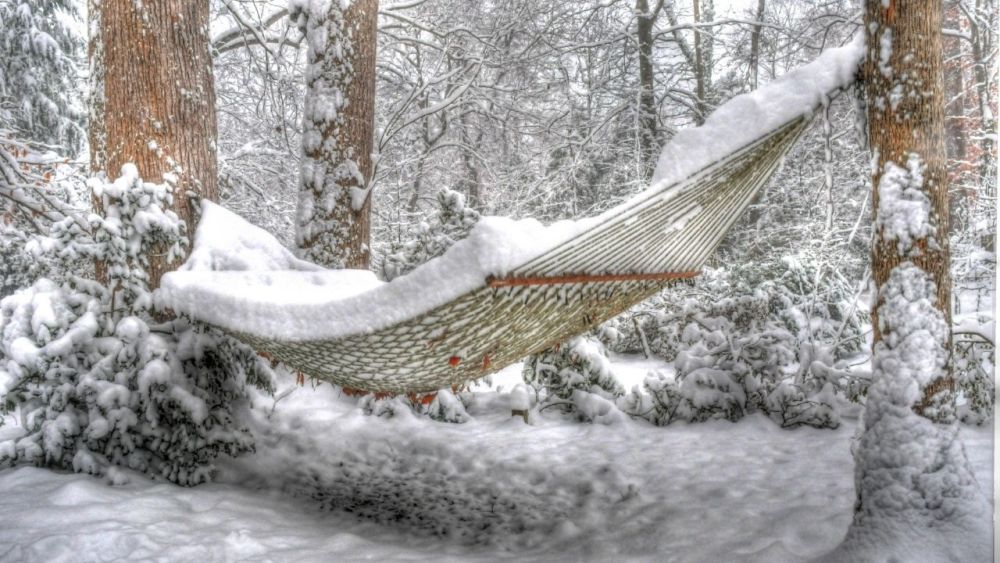
How to sleep safely and warmly in the hammock during winter
👉 The key facts from this guide
- Select the right equipment for sleeping in a hammock during winter. This includes a suitable hammock, a sleeping bag, a sleeping pad or underquilt, a tarp, and appropriate clothing.
- Monitor the weather and prepare for cold and frost. Avoid camping in snowy regions when a snowstorm is announced.
- Find a suitable spot to hang your hammock. Avoid dead trees and potentially falling branches. Watch out for avalanche risks in mountainous regions and avoid areas with potential flash floods.
- Create a plan for your trip and share it with at least one person. This way, someone knows where you are and can send help in case of an emergency.
- Always be ready to cancel your venture due to weather or other reasons. Safety should always be the top priority.
Winter is here, and you might think that your hammock needs to rest for a few months?
Wrong! With the motto There is no bad weather, only the wrong gear, you can also spend a wonderful time in the wilderness during the winter months with the right preparation.
Although you have to consider a few things, don't be discouraged by the many steps. In the end, this allows you to have an incredible experience in the cold season with an increased coziness factor.
Here, I will go through everything step by step so that you are well-prepared for the cold and can assess the circumstances accordingly.
1. Why sleep in a hammock in winter?
Maybe you stumbled upon this article out of curiosity and are wondering: Why would anyone want to sleep outside or even in a hammock in winter?
Winter seems barren and colorless. There is little life in nature, and above all, it is very cold. But upon closer inspection, nature has its magic in winter.
Various seasons shape life on our planet. Their perpetual cycle determines the survival of plants and animals and offers new opportunities.
A special form of silence can be observed, and especially snow transforms the landscape into a painting-like existence.
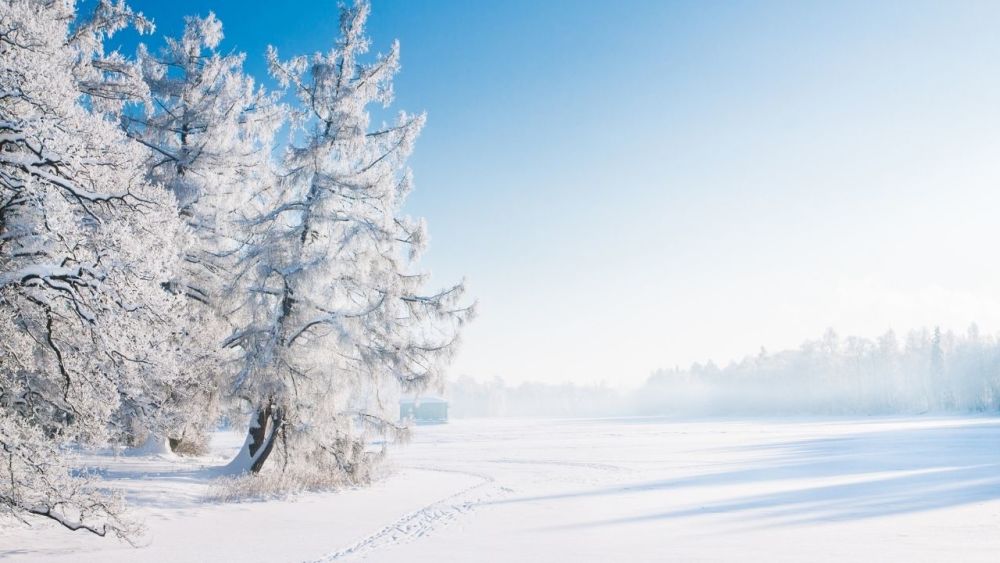
To enjoy this, you need the optimal equipment and preparation to be prepared for the cold and potential dangers in the hammock.
If you have ever slept in a hammock in other seasons, you know that your back can get chilly. Unlike in a tent, your weight compresses all the layers under you, and you lose a lot of heat here.
Just a sleeping bag is often not enough. Therefore, the right insulation is essential to keep the warmth with you and provide you with restful sleep.
2. Hammock in winter as a beginner?
If you haven't slept in a hammock even in summer, I advise you not to try it directly in winter.
If you are still eager to try this, then take your car with you. Here you can pack all the provisions you require and are not limited by your backpack.
In an emergency, you can retreat to your car or abandon your undertaking. Alternatively, you can also search for a place near your home.
Read also: Sleeping in a hammock: important basics for beginners and necessary equipment.
3. Observe the weather
Before you start your trip, you need to inform yourself about the weather conditions there. If the temperatures at night are above 0 degrees, everything is still fine, but below that, you must prepare yourself perfectly for the cold and frost! More on that later.
If you are traveling in snowy regions and the weather forecast announces a snowstorm, your alarm bells should ring.
In a snowstorm, the winter wonderland quickly becomes a major danger, especially in a hammock. Even the best equipment won't help.
For longer stays in the wilderness, it is essential to know the weather forecast or to be able to interpret the signs of a storm yourself. The latter will bring you even closer to your nature experience!
In mountainous regions, there is another danger: avalanches. The areas are usually marked with the corresponding probability. There is also a so-called avalanche forecast for each area.
In addition, you must be familiar with the conditions for an avalanche to minimize the risk. In short: do not camp on a slope or directly at the foot of a mountain covered with fresh snow.
In addition, extreme rainfall and freezing should not be underestimated. Rather postpone your undertaking than expose yourself to such extreme situations.
Read also
Camping in a Winter Storm: These 11 Tips Will Help You Stay Safe - A winter storm can be a dangerous thing when camping. Take the necessary steps to stay as safe and comfortable as possible.
4. Equipment
As mentioned above, everything stands and falls with preparation. Therefore, take your time and pack your backpack carefully.
It is important to rely on high-quality products and not to save money in the wrong places. This is especially true for temperatures below 0 and for days with snow.
Below, I will describe the various items and their function. This will enable you to put together the best equipment for you based on the conditions of your environment and your preferences.
Hammock
Most camping products work great with hammocks, but you should avoid those made of cotton. Furthermore, the hammock should be compatible with winter accessories, as conventional nylon hammocks offer little protection from below.
Sleeping Bag
Some summer nights are already borderline without a sleeping bag. Therefore, I see the sleeping bag (here is my top list) as essential and recommend not to save money there.
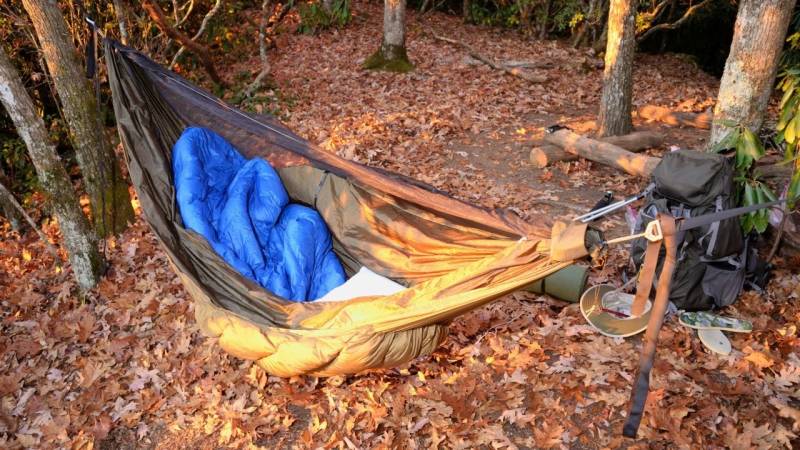
Pay attention to the minimum temperature of your destination and choose your sleeping bag accordingly. Subtract another 5-10 °C to be on the safe side.
A small example: With a minimum temperature of -5 °C in your destination region, you should select a sleeping bag rated for at least -10 °C, preferably -15 °C.
In addition, you should take into account an error tolerance of the manufacturer. To come back to the example, I ultimately recommend a sleeping bag that can withstand at least -20 °C.
My clear recommendation would be a mummy sleeping bag, as it protects you all around and adapts optimally to your body in the hammock.
Alternatively, you can also use a not so good sleeping bag and add a sleeping bag liner. This will give you a few more degrees.
Insulation Mat
An insulation mat is your first protection against cold from below. The mat is placed directly in the hammock or inserted into a specially designed compartment.
You can either use a regular insulation mat or get one specifically designed for hammocks.
In my experience, it was really nerve-wracking to sleep in a hammock with a regular insulation mat. It kept slipping, and I had to tighten my hammock more and more to sleep through the night comfortably.
Therefore, I recommend trying either a hammock with a compartment or the adapted insulation mat.
In the end, an insulation mat is not a must, especially if you own an Underquilt.
Underquilt
In very low temperatures, you can't avoid an Underquilt. It protects you from below by enveloping the hammock from below like a second layer.
Depending on the temperatures you expect at night, you will need to choose your Underquilt accordingly.
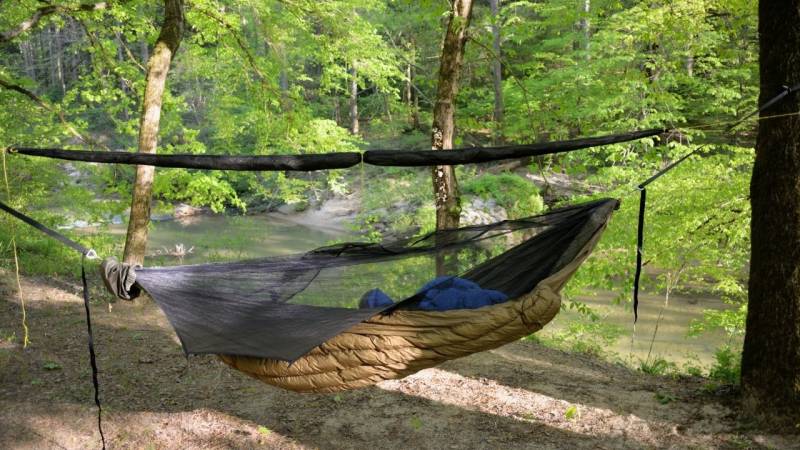
You can read exactly what an Underquilt is and why it is so useful in my guide "Sleeping in a hammock: why the Underquilt completes your equipment - the solution to cold nights?".
Topquilt
Similar to the Underquilt, a Topquilt is also useful to protect you from the cold from above.
Keep in mind that a Topquilt does not protect you from the weather. While your sleeping bag usually stays dry, rain or snow can still get in around your face.
Therefore, I recommend also setting up a tarp, but more on that later.
Topquilt and Underquilt can be combined, creating a pea-pod system.
A Topquilt is worth considering for particularly low temperatures, but not a must-have.
Kokoon
The cocoon or sock is a fusion of under- and Topquilt. This insulation system completely encloses the hammock, and you can imagine it like a big caterpillar to get cozy in.
Tarp
Even if no rain or snow is expected, I highly recommend a tarp.
Weather reports can be wrong, and the weather can change quickly. Since your hammock is typically not protected from moisture, a tarp can make a difference.
The tarp provides an additional layer that doesn't directly touch your hammock and also protects against wind.
In addition, the additional layer insulates, provided the tarp is properly tensioned. The tarp should not touch the hammock, but still be close enough to you.
Furthermore, a wall should be set up in the direction of the wind.
There are tarps available in all sorts of shapes and even specifically for hammocks. Some have doors at the front and back, so you are protected from all sides.
In my list of the best tarps plus accompanying buying guide, you will surely find one that meets your needs.
You can read here how to sew your tarp.
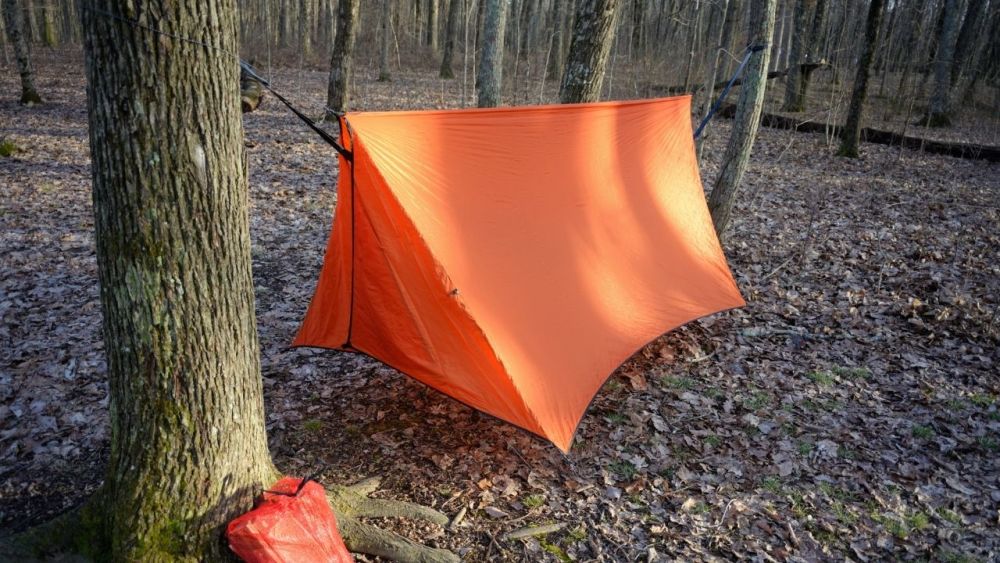
Additional blankets
Blankets or other textiles offer an additional insulation layer, but also take up more space.
If you are traveling by car, this is not a problem, but as a backpacker, this can quickly become a disadvantage.
It's better to pack less but higher quality equipment, rather than carrying everything through the wilderness like a donkey.
Clothing
It is essential that you also have suitable clothing for winter. There are some things you can keep in mind when camping in a hammock.
If possible, store dry clothing in your hammock before sleeping (if it's dry), so you don't have to climb into your "bed" with wet clothes.
Even with the best equipment, the night can quickly become uncomfortable if you are still completely soaked.
Moreover, make sure your clothing keeps you warm, and you are well protected from the cold during the day. Because if you climb into your hammock already chilled, it will be more difficult to warm up.
Warm, thick socks are necessary. My feet often get cold first, so I always appreciate fluffy socks to sleep in.
In addition, a high-quality hat never hurts. You can also pull it over your face while sleeping for additional protection. Make sure to keep your mouth and nose free so you can breathe well.
Read also
The Ultimate Guide: What Clothing to Wear for Survival and Bushcraft Training? - The right clothing can make the difference between life and death in survival situations. In this guide, we'll go over what you should wear outdoors.
5. Find the Suitable Place
Search for a place that is sheltered from the wind if possible. Large rocks or a dense forest are suitable for this purpose.
Avoid camping directly on a cliff. If you're lucky, the wind will blow from the other side. However, if the location is bad, the wind will blow along the cliff and make for an uncomfortable night.
Lower areas such as dry riverbeds may seem sensible at first, but they collect both cold air and water at night.
Additionally, keep your eyes up. Avoid dead trees near your hammock and try to identify potentially falling branches. Especially in snowfall, the additional weight puts stress on trees and larger branches can come crashing down.
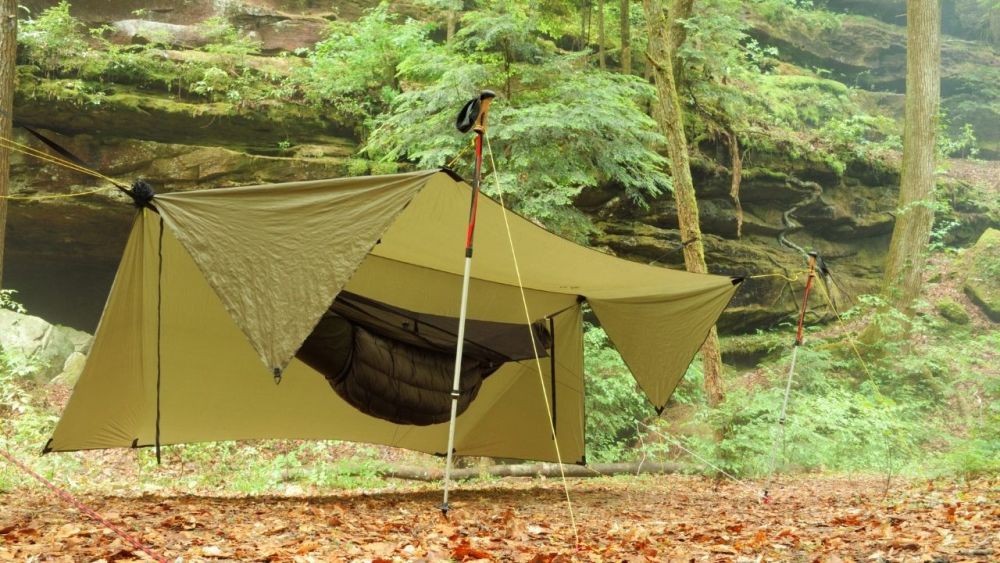
As mentioned above, keep avalanche danger in mind and avoid areas prone to flooding.
Take your time to observe your surroundings and explore the area carefully.
Recommended Reading: How to Find the Ideal Location for Your Bushcraft Camp
6. Make a Plan
Before embarking on your trip, make a plan.
It helps you keep track of things, and you can go through the trip in your head. This way, you may think of equipment that you had not considered before.
Moreover, write down your plan and tell at least one person where you are going. That way, you are not completely on your own in dangerous situations, and rescue teams know where to look for you in case of an emergency.
A plan might look something like this:
Day 1: Travel to camping destination (approximate route) and set up my camp (ideally give your coordinates or a nearby landmark). Spend first night here.
Day 2: Camp remains in place. I go over (route) to (coordinates) in the morning. In the afternoon, I return via (route) and report my arrival (if there is a phone network).
Day 3: Break camp. Seek out a new camp at (coordinates) via (route).
Day 4: Return home via (route).
Continue the plan as you see fit and as necessary, and try to stick to it as much as possible.
It is also not a shame to cancel your venture due to weather or other reasons. Even if you were excited for the experience, there will be a more suitable time for it.
What's important is that you always keep the first survival rule in mind: never take a risk.
7. Conclusion
A well-thought-out plan and good preparation make winter nights in a hammock almost a comfortable place.
Invest enough money and time here. Moreover, don't be too hasty at your desired camping location. Explore your surroundings carefully and pay attention to weather conditions.
Common sense and the knowledge from this article provide a good basis.
If you do find yourself in an emergency situation, stay calm and try to contact your emergency contact. Even without a network, they should have your coordinates and the chances are good that you will be found.
However, that should not be the last sentence on this topic, as sleeping in a hammock in the winter is often a unique experience.
Enjoy the peace and beauty of winter to the fullest. You will be one of the few who dare to take on and experience such a challenge.


Author of the guide
Martin Gebhardt
Hey, I'm Martin. On my blog, you will learn the basics and numerous details about living in the wild. I think survival, bushcraft and the good life in nature are the keys to happiness. Find me here on Instagram or on YouTube. You can find more about my mission on the About Me page.
Was this guide helpful?
14 people found this guide helpful.
5.00 out of 5 points (14 Ratings)
Comments (0)
This post may contain affiliate links. So if you click on the links and make a purchase, I will receive a small commission at no additional cost to you. Click here, to learn more about it.


